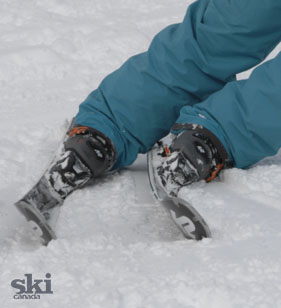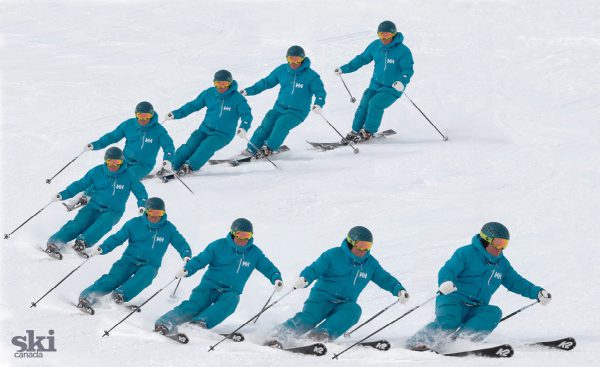In skiing, often our main goal is to link a series of turns to create a sequence. While generally round, these turns can take many shapes, depending on our speed (fast, medium, slow or anywhere in-between) and the slope (steep, moderate or flat).
For instance, on a steep slope going at a fast speed you may prefer a rounder, deeper turn. Deeper means a longer-radius length, a greater distance from the centre of the arc to the outer edge of the circle of the turn. The goal with this approach would be to ski at a controlled safe speed to enjoy the run.
Conversely, on a flatter slope you may prefer a turn that’s less round, shallower with a shorter-radius length, less distance from the centre of the arc to the outer edge of the circle. The goal here may be to ski the run at a consistent safe speed with a turn that is less round (not completed as much) so it will not slow your speed down too much.
In order to vary turn shape, you need to do two things: edge the ski and turn the legs.
To edge the ski simply roll the ankle, knee and hip inside toward the centre of the circle (your turn). You can start with the ankle, then the knee and hip, but ideally they should all move inside together.
To turn the legs simply start by pointing all your toes in the direction you want to go. This effort needs to include the entire leg, including the quadriceps/upper thigh, but stops at the top of the leg so the hip isn’t included in the turning effort.
The challenge is to blend these two efforts together with the right combination to match the speed and slope. The ultimate outcome is the ability to make any shape and size of turn on any slope we choose. And if your turn resembles a circle or arc of some shape, there must be direction travel not only down the hill, but across the hill as well.
The blending of these two factors in the right scenario provides what is called efficient technical skiing through rotational angulation. We don’t simply ski straight down the hill, we ski across it as well. In simple terms, skiing is not only top to bottom, but left to right and right to left.
Edging is a gradual process, where you begin to tip the skis and gradually increase the edge angle as you travel through the turn along the arc.
Turning the legs is also a gradual process. You begin slightly at first and continue as you travel through the arc. Turning the legs with the skis on the snow does not actually result in the skis physically turning, but it is more of a helper. As you start to travel, the turning effort has a turning effect on the skis and the shape of the arc you are making.
Smaller Edge Angle
In the main image sequence the ski is tipped up more toward the inside of the circle in the last few frames than it is during the first two frames.

Larger Edge Angle
You can also see the upper body (hips, hands, chest, shoulders) facing away from the inside of the circle. This is the result of turning the legs and maintaining the turning effort right through to the end of the arc.
Try to match and blend these two efforts and you will get rotational angulation. Start on a flat easy slope and work your way up to something more advanced. When you get the right blend, the turn feels smooth, easy and strong.
As you increase the speed and slope, in addition to the turn feeling easier, your vertical speed, top to bottom, should be safely consistent.
Practice varying these movements. Perform them quickly and you will get a short turn. Perform them more gradually and you will get a longer turn. All of a sudden you are in control of and varying your turn shape, according to any conditions or slopes you may encounter.





